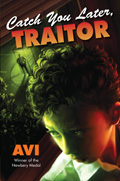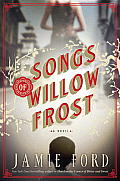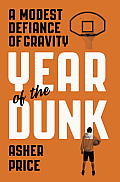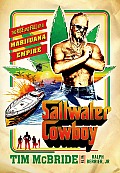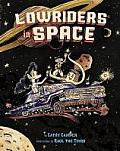Link to this review in the form of a comic strip by billba tagged coming of age • historical fiction • mystery
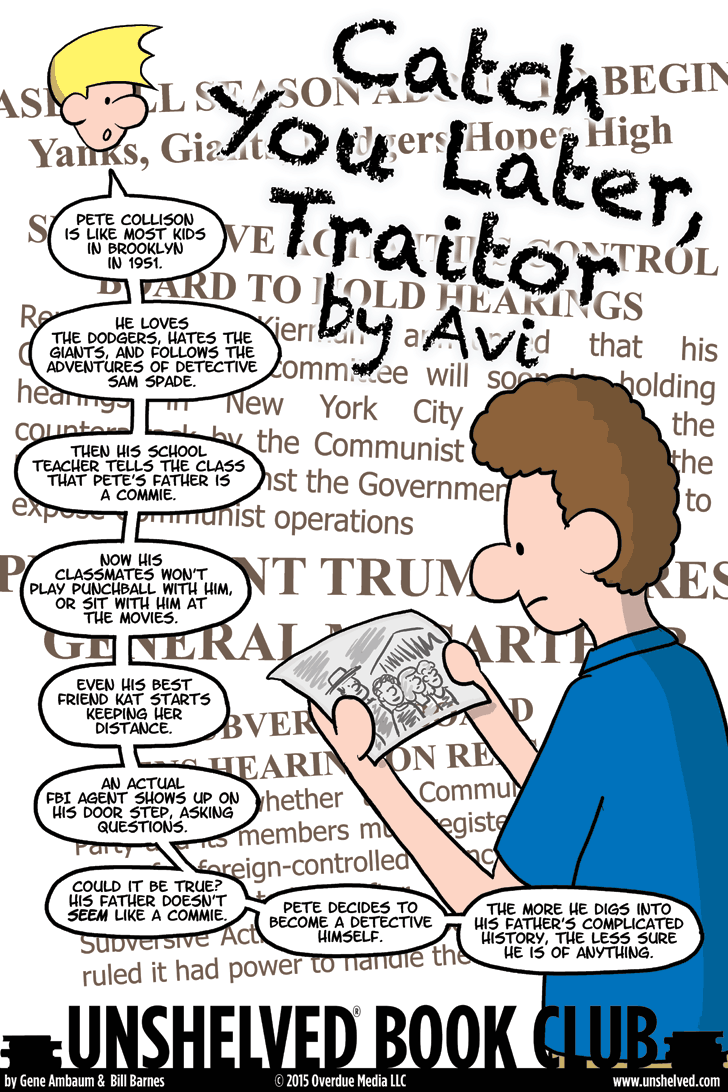
Click for the full-sized comic
Why I Picked It Up: Workman’s Michael Rockliff has seldom led me wrong, and certainly he didn’t this time.
Link to this review by flemtastic tagged coming of age • romance
Quinn’s boyfriend died during their junior year of high school. She was heartbroken, and has been slow to recover. As part of remembering and honoring Trent, she writes to all the recipients of his organs. Only one doesn’t write back — Colton, the boy who got Trent’s heart. Quinn tracks him down and observes him from afar at the surf shop where he works. They meet after a minor car accident, but as they start to fall for each other Quinn continues hiding their other connection.
Why I picked it up: I read Kirby’s Moonglass years ago and appreciated it, and when she autographed a copy of Golden for my daughter at a recent library conference, I really appreciated it. I swore that I would read all of her new books.
Why I finished it: Waiting for Quinn to reveal her big secret to Colton was nerve-wracking. I knew it was going to be a bombshell, but it had to happen; it wasn’t fair of her to hide that information forever. The sweet romance between them that grows organically, like those short montages in movies that show two characters laughing and cavorting through multiple scenes to establish that they have spent a lot of time together and love each other, except this is much better described and more fun. The surrounding characters were also much more than mere extras. I particularly loved Quinn’s older sister, who would not stand for Quinn’s dissembling. She immediately understood that Quinn had the hots for Colton and then grilled her about their relationship until Quinn broke down and told her everything.
It’s perfect for: Megan, a student at my school who enjoys surfing. She will love that this book takes place at the beach, where Quinn and Colton have several of their hottest dates. Since she is a middle schooler, I think she will like watching them circle each other as they try to deal with their feelings.
Link to this review by darcy tagged historical fiction • coming of age
William is a Chinese-American boy living in a Seattle orphanage during the Depression. One day William sees his mother, a famous actress now going by the name Willow Frost, on the big screen in a movie house. William and his best friend Charlotte, a blind girl who also lives at the orphanage, hatch a plan to escape and find his mother while she is still in town. When William catches up with her, he learns the truth about his father and why his mother abandoned him.
Why I picked it up: My book group chose it because we loved Ford’s Hotel on the Corner of Bitter and Sweet so much.
Why I finished it: I was drawn into the story of the beautiful Liu Song in 1920s Seattle. As a single mother, she sang songs outside a music store and danced in night clubs to support her son. Suitors came and went, but she held on to a man she believed would return for her, so they could marry and William would have a father. When William caught up with his mother, she told him her story, starting with her early life as Liu Song to her journey to fame as the actress and singer Willow Frost. The details of her story, which included Skid Row, vaudeville, and Chinese culture, kept me hooked.
It’s perfect for: My grandmother, who loves Seattle history. She lived in Seattle after WWII and will love the way Ford describes Smith Tower, which was then the tallest building west of the Mississippi. She will also enjoy the compelling characters, particularly the humor behind their names such as the kid in the wheelchair the other orphans refer to as “Marco Polio,” and William’s native friend, Sunny Sixkiller, who chose his own last name because it sounded tough.
Link to this review by emilyreads tagged history
Professor, essayist, and cultural critic Ilan Stavans offers a different take on the American experience, drawing on his scholarly expertise and personal story as an adult immigrant from Mexico. The book follows a fairly standard chronology, but with a narrative imbalance that skews heavily to the present, interspersed with figures and events from other nations that typically get short shrift in U.S. histories (José Martí, the Mexican Revolution, and Julia de Burgos). Stavans shows affection for his adopted country, but also skepticism and doubt. “I’m always amazed at how Americans treat their flag like a sacred object,” he writes, “becoming incensed when anyone desecrates it, yet they use the flag as a motif on coffee mugs, pencils, watches, and underwear.” It’s a critical work that nonetheless avoids demonizing or scapegoating the nation as a whole.
Why I picked it up: I’m always looking for graphic-novel nonfiction: it’s the perfect way for me to get a decent handle on an event or historical period in an easily digestible format.
Why I finished it: I was intrigued by some of the connections Stavans makes within and between eras and events: McCarthyism and Marilyn Monroe’s red lipstick, for example, and the immigration boom of the early twentieth century and modern-day bilingual education.
It’s perfect for: Fans of Howard Zinn’s A People’s History of the United States. Stavans takes a similarly populist approach, but his outsider status adds another layer of skepticism to the traditional forward-progress narrative of the U.S. Or give it to your favorite, conservative-learning relative for Christmas, just to irritate him or her.
Link to this review by geneambaum tagged picture book • comic strips
Two-page comic strip adventures of a pipe smoking man in a wrinkled coat and hat who wanders through days filled with beautiful coincidences. A touch of tunnel vision coupled with a sense of wonder allows him to enjoy things that would otherwise be irritating. His kindness and imagination are on continuous display.
French director Jacques Tati made four comedic films starring the blundering Monsieur Hulot in the 1950s and 1960s. This is one of two books of comic strips Merveille created after catching Hulot fever, and the only one published in the U.S.
Why I picked it up: Krista Hughes told me I should read it after Bill and I gave our graphic novel talk at the Pennsylvania Library Association’s conference in October.
Why I finished it: The first page always sets up the gag, often in an unexpected way. In the first, Hulot buys a snow globe featuring the Eiffel Towwer. He goes outside in Paris, where he can see the tower itself, and turns it over. It starts snowing. Nice gag. But the beauty of this is the way the page turn works. It reveals the action (turning it over), the location (Paris), and the snow all at the same time, in one burst. (The second page of these comics is always a single, giant panel.) Comics that use the page turn this well are rare, and I’ve never seen it done in a comic strip. It’s simply brilliant, and Merveille uses it throughout the book.
This review contains several of Mereville’s two-page comic strips, including my favorite, which is the one with the flamingos.
Readalikes: The Adventures of Polo by Régis Faller, another wordless French comic disguised as a picture book. There are several books in the Polo series, all of which follow a dog on magical, whimsical adventures around the world. Polo: The Runaway Book will appeal to every book lover you know.
Link to this review by flemtastic tagged nonfiction
At thirty-four, Asher Price, possessor of a “vague athleticism,” realized that if he was ever going to dunk it would have to be soon. Over six feet tall with long arms, Price figured he had a shot. He gave himself a deadline: one year. He studied with professors of kinetics, trained with a former Olympic high jump champion, and worked out daily, dropping from 202 pounds to an extremely fit 175. As the day to prove his prowess approached, he became more and more nervous about whether he would succeed.
Why I picked it up: One of my greatest athletic accomplishments is that I once dunked a volleyball on a legitimate, regulation basketball hoop. (My hands are too small to palm a basketball.) Because I’m 5’9” that means I have serious ups, yo! Of course, that was back when I was twenty-five and at my peak, but I still brag about it all the time. So I could totally identify with Asher’s preoccupation.
Why I finished it: I was rooting for Asher the whole way. He had to overcome some difficulty earlier in his life when he beat testicular cancer. (The doctor that diagnosed his condition was named Dick Chopp. Asher, like Lance Armstrong (whom Asher corresponded with), ended up with one testicle.)
And I loved the weird advice Asher got. One woman passed along what she had heard about ninja jump training, that Asher should jump over a hemp plant every day. As it grew, so would his jumping ability.
It’s perfect for: My buddy Derek, a scientist who also plays basketball. (Derek’s claim to fame is that he once jammed home a tip dunk during a game.) And he will enjoy the science about long-twitch and short-twitch muscle fibers.
Link to this review by wally tagged mystery
Michael Seeley, an attorney with a noble streak and an alcohol problem, reluctantly helps an aging Cuban musician who wants the rights to his music back. His partners try to dissuade him, but soon he is in Cuba, where, with the help of his beautiful translator, he struggles to find the musicians, avoids the local police, and steer clear of several other shady characters.
Why I picked it up: Paul Goldstein is a distant relative of mine, according to my second cousin. And I don’t usually read mysteries or legal thrillers, but the thought of a visit to Cuba sounded good.
Why I finished it: Surprisingly I was drawn in by the legal wrangling between all the different characters. It was like watching a chess game with big money (and, eventually, lives) at stake.
It’s perfect for: George, who has been to Cuba himself, although he didn’t have to fight a nasty police lieutenant to save his translator or deal with a raging desire for rum.
Link to this review by flemtastic tagged biography
A friend asked Tim McBride to help with a project. He made $50,000 in one night by moving bales of marijuana from a tanker in the Gulf of Mexico into smaller boats for transport to shore. From that point on, McBride was deeply involved in marijuana transport. After the boss was taken down in a sting, McBride stepped into the role and flourished, moving over thirty million pounds of marijuana to the mainland in the 1980s. He was ultimately arrested and sentenced to a decade in prison, which he also tells about.
Why I picked it up: When I heard that McBride had smuggled thirty million pounds of marijuana into the U.S., I had to know how.
Why I finished it: McBride’s crew was paid by the pound! Once, he drove a Winnebago that had been stripped of everything below the window line, including seats, so that they could cram it full of marijuana bales. They even had airbags under the shocks, so that when it was fully loaded, the vehicle wouldn’t ride low and look suspicious. After earning millions, McBride had too much cash to put in a bank without tipping off the authorities, so he had to find interesting ways to spend it. One was to purchase an $80,000 cigarette boat that he used to outrun the Coast Guard on multiple occasions.
It’s perfect for: My friend Neal, who used to live in rural Montana. He always talked about small towns, how the locals feel about outsiders and how everyone knows what’s going on. McBride benefitted from a very similar “small town” feel — so many locals were involved in his operation that no one wanted to talk to the police.
Link to this review by geneambaum tagged graphic novel
Lupe Impala (mechanic), Flapjack Octopus (eight-armed car polisher), and Elirio Malaria (mosquito, paints details with his beak) work together at Cartinflas Carros Usados.* But they dream of having their own garage and their own low and slow ride. When they see a poster for the Universal Car Competition, they decide to fix one up and enter. If they win, they’ll have enough money to buy their own shop. At an airplane graveyard, they find a few boxes of rocket parts. They soon blast into space and find unique ways to customize their cosmic lowrider.
*Cartinflas Used Cars. (There are Spanish terms throughout, with easy to find definitions.)
Why I picked it up: Cover blurbs from non-comics folks, including Amy Sedaris, Megan McDonald, and Davy Rothbart (founder of FOUND).
Why I finished it: Raúl The Third drew the whole thing in red, blue, and black ballpoint pen. In his note at the end, he says he did this to “revisit the excitement I felt as a kid whenever I drew.” It comes through on every page, and is the perfect style for this anything-can-happen tale with its bizarre characters and fantastic plot. (I’m happy to tell you the book isn’t lettered in ballpoint, which would have made it hard to read. The words are crystal clear.)
It’s perfect for: There was a guy who came into the library I worked in, who wanted me to remove Lowrider from the teen section because of the bikini-clad girls on the cover. (Apparently he’s never heard of the internet.) I explained the appeal of the book to some of our patrons, that it was there for other things it offered (and not the girls), and frankly told him that there wasn’t a chance that we’d be removing it, though he was welcome to tilt at that particular windmill if he wanted to. We had a good talk, and he left, but he wasn’t happy when he walked out the door. I’d give him this because it would do a better job explaining lowrider culture and might give him a chuckle, too. (If this sounds familiar, it might be because we did an Unshelved sequence about this a few years back.)
